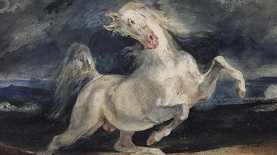
‘Boggle threshold’ is a colloquial term used to refer to the level of tolerance of any anomalous claim or new idea, which is likely to vary from one person to another. It was coined by the British historian and psychical researcher Renée Haynes in 1980, writing in the context of disbelief of paranormal claims.
Background
The word ‘boggle’ originally referred to horses starting with fright and probably derives from ‘bogle’ and ‘bogey’, meaning evil spirits, which in pre-modern times horses were thought to be able to see.1 Hence the common expression ‘the mind boggles’, meaning the adverse mental reaction caused by an apparently outlandish idea.
Renée Haynes
Renée Haynes was a British writer who became interested in paranormal phenomena from her experiences of precognitive dreams. She is the author of The Hidden Springs: An Enquiry into Extra-Sensory Perception (1961) and The Society for Psychical Research 1882-1982: A History (1982).
In a 1980 article written for Encounter magazine, Haynes described what she called ‘the boggle threshold’, by which she meant the mental equivalent of the concept of the pain threshold, the point at which a person becomes aware of, and starts to react to, physical pain.2 As a child, Haynes had been struck by observations made by Thomas Henry Huxley – as described to her by her grandmother, who was Huxley’s daughter – during exploratory expeditions in Australasia, where he saw Aboriginal natives sometimes walking around with open wounds and even broken bones, injuries which would have crippled European sailors. Likewise, she felt, a high ‘boggle’ threshold prevents some people from perceiving things that objectively exist but which seem ‘totally unfamiliar and incomprehensible’, either dismissing them as impossible or reformulating them in familiar terms.
As examples, she cites the case of the French scientist Antoine Lavoisier, who dismissed accounts of meteorites that later proved to be true, and nineteenth century doctors sceptical of hypnosis claims, who preferred to believe that patients able to endure painful operations under hypnosis were ‘shamming’. It is also shown, she argues, in the response of most educated people in the nineteenth century to claims of psychokinetic activity associated with reports of poltergeists and spiritualist séances, contradicting positive verifications by some scientists and investigators.
Haynes writes:
Individual boggle thresholds will vary … with individual temperament, history, training, and aptitude. They will also be influenced by … the groups to which each individual is linked: family, friends, school, employment, university. In people brought up in the discipline of the physical sciences the levels of boggledom are likely to differ considerably from the levels found in those brought up in the humanities.3
She argues that the boggle threshold is ‘normal, necessary, and useful in every context’ and in the field of psychical research ‘it is essential if the line is to be drawn between mystery and mystagogy’. She adds:
The existence of this threshold, however, needs to be recognised and reckoned with, its level needs to be examined consciously and constantly, and kept low enough for the mind to admit evidence for hard angular facts, however difficult it may be to fit them into an existing pattern. It should, on the other hand, be kept high enough to eliminate ‘explanations’ that are no more than phosphorescent verbiage … and to reject hypotheses that do not bear testing and the wilder vagaries of science fiction …4
Haynes referred to her coining of the term in the introduction of her history of the SPR, where she writes:
‘Partiality, prejudice and passion’ probably have much to do with what I have called – by analogy with the pain threshold which varies so much from one individual to another – the Boggle Threshold, the level above which the mind boggles when faced by some new fact or report or idea.5
Usage
The term ‘boggle threshold’ is now widely used by parapsychologists when discussing extreme scepticism of paranormal claims, however well evidenced,6 as well as by mainstream writers and commentators.7
Robert McLuhan
Literature
Haynes, R. (1961). The Hidden Springs: An Enquiry into Extra-Sensory Perception. London: Hutchinson.
Haynes, R. (1982). The Society for Psychical Research 1882-1982: A History. London: Macdonald.
Haynes, R. (1980). The boggle threshold. Encounter (August), 92-96.
Luhrmann, T.M. (2014). Where reason ends and faith begins. New York Times (July 26).
Tréguer, P. (n.d.). The curious origin of ‘the mind boggles’ Word Histories. [Web page]

